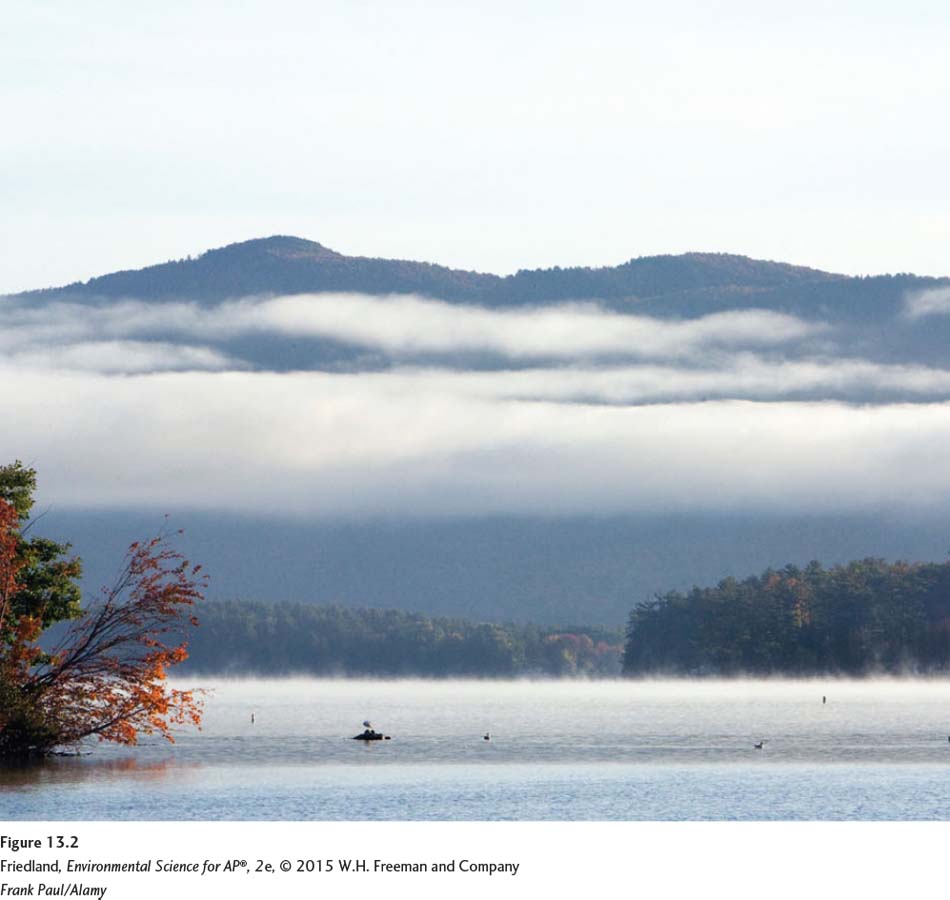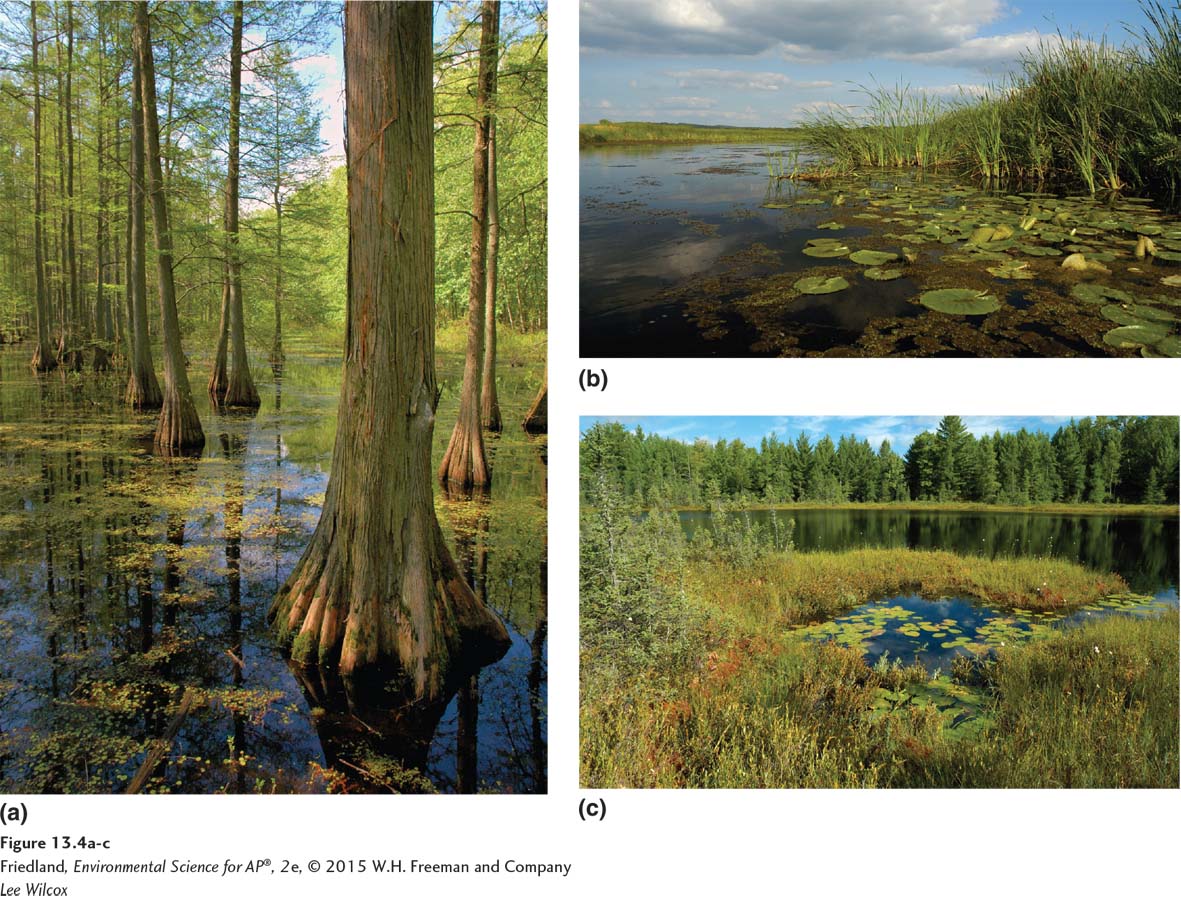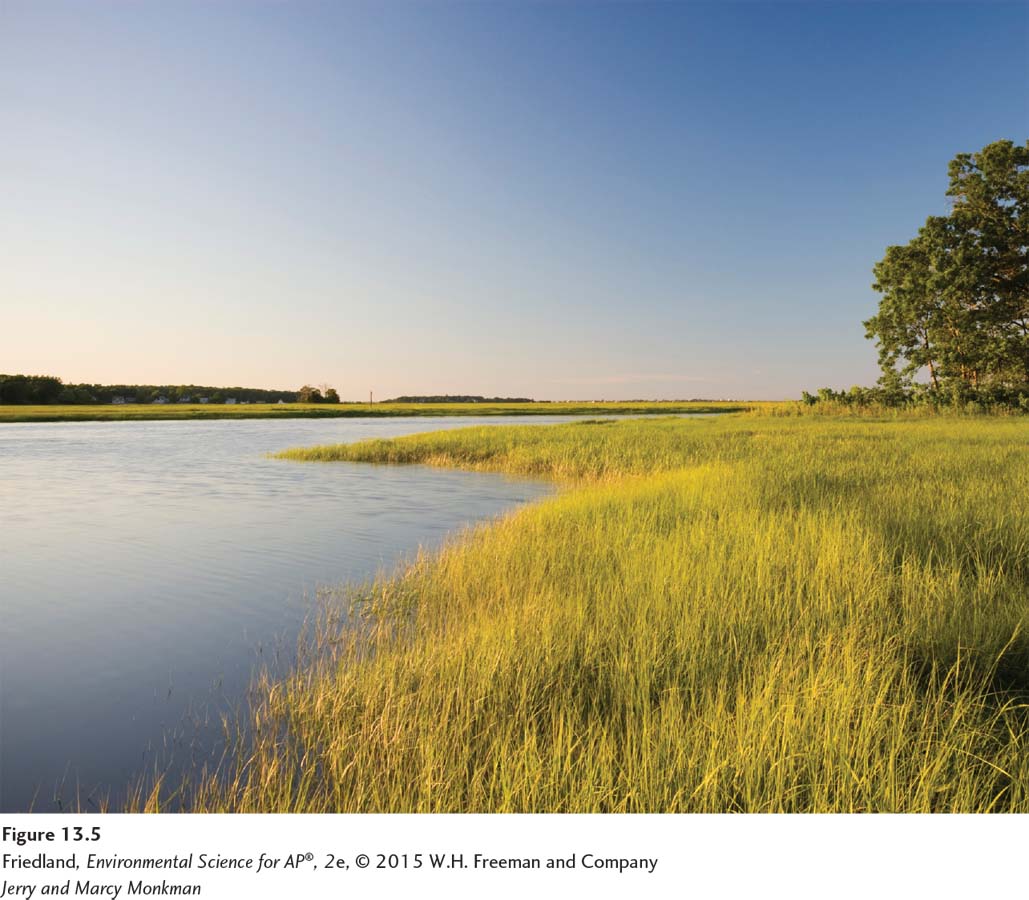module 13 Aquatic Biomes
Whereas terrestrial biomes are categorized by dominant plant growth forms, aquatic biomes are categorized by physical characteristics such as salinity, depth, and water flow. Temperature is an important factor in determining which species can survive in a particular aquatic habitat, but it is not a factor used to categorize aquatic biomes.Aquatic biomes fall into two broad categories: freshwater and marine. Freshwater biomes include streams, rivers, lakes, and wetlands. Saltwater biomes, also known as marine biomes, include shallow marine areas such as estuaries and coral reefs as well as the open ocean.
Learning Objectives
After reading this module you should be able to
identify the major freshwater biomes.
identify the major marine biomes.
Freshwater biomes have low salinity

Freshwater biomes can be categorized as streams and rivers, lakes and ponds, or freshwater wetlands.
Streams and Rivers
Streams and rivers are characterized by flowing fresh water that may originate from underground springs or as runoff from rain or melting snow (FIGURE 13.1). Streams (also called creeks) are typically narrow and carry relatively small amounts of water. Rivers are typically wider and carry larger amounts of water. It is not always clear, however, at what point a particular stream, as it combines with other streams, becomes large enough to be called a river.
As water flow changes, biological communities also change. Most streams and many rapidly flowing rivers have few plants or algae to act as producers. Instead, inputs of organic matter from terrestrial biomes, such as fallen leaves, provide the base of the food web. This organic matter is consumed by insect larvae and crustaceans such as crayfish, which then provide food for secondary consumers such as fish. As fast-

Fast-
Lakes and Ponds
Lakes and ponds contain standing water, at least some of which is too deep to support emergent vegetation (plants that are rooted to the bottom and emerge above the water’s surface). Lakes are larger than ponds, but as with streams and rivers, there is no clear point at which a pond is considered large enough to be called a lake (FIGURE 13.2).
Littoral zone The shallow zone of soil and water in lakes and ponds where most algae and emergent plants grow.
Limnetic zone A zone of open water in lakes and ponds.
Phytoplankton Floating algae.
Profundal zone A region of water where sunlight does not reach, below the limnetic zone in very deep lakes.
Benthic zone The muddy bottom of a lake, pond, or ocean.
As FIGURE 13.3 shows, lakes and ponds can be divided into several distinct zones. The littoral zone is the shallow area of soil and water near the shore where algae and emergent plants such as cattails grow. Most photosynthesis occurs in this zone. In the open water, or limnetic zone, rooted plants can no longer survive; floating algae called phytoplankton are the only photosynthetic organisms. The limnetic zone extends as deep as sunlight can penetrate. Very deep lakes have a region of water below the limnetic zone, called the profundal zone. Because sunlight does not reach the profundal zone, producers cannot survive there, so nutrients are not easily recycled into the food web. Bacteria decompose the detritus that reaches the profundal zone, but they consume oxygen in the process. As a result, dissolved oxygen concentrations are not sufficient to support many large organisms. The muddy bottom of a lake or pond beneath the limnetic and profundal zones is called the benthic zone.

Oligotrophic Describes a lake with a low level of productivity.
Mesotrophic Describes a lake with a moderate level of productivity.
Eutrophic Describes a lake with a high level of productivity.
Lakes are classified by their level of primary productivity. Lakes that have low productivity due to low amounts of nutrients such as phosphorus and nitrogen in the water are called oligotrophic lakes. In contrast, lakes with a moderate level of productivity are called mesotrophic lakes, and lakes with a high level of productivity are called eutrophic lakes.
Freshwater Wetlands
Freshwater wetlands An aquatic biome that is submerged or saturated by water for at least part of each year, but shallow enough to support emergent vegetation.
Freshwater wetlands are aquatic biomes that are submerged or saturated by water for at least part of each year, but shallow enough to support emergent vegetation. They support species of plants that are specialized to live in submerged or saturated soils.
Freshwater wetlands include swamps, marshes, and bogs. Swamps are wetlands that contain emergent trees, such as the Great Dismal Swamp in Virginia and North Carolina and the Okefenokee Swamp in Georgia and Florida (FIGURE 13.4a). Marshes are wetlands that contain primarily nonwoody vegetation, including cattails and sedges (FIGURE 13.4b). Bogs, in contrast, are very acidic wetlands that typically contain sphagnum moss and spruce trees (FIGURE 13.4c).

Freshwater wetlands are among the most productive biomes on the planet, and they provide several critical ecosystem services. For example, wetlands can take in large amounts of rainwater and release it slowly into the groundwater or into nearby streams, thus reducing the severity of floods and droughts. Wetlands also filter pollutants from water, recharging the groundwater with clean water. Many bird species depend on wetlands during migration or breeding. As many as one-
Marine biomes have high salinity

Marine biomes contain salt water and can be categorized as salt marshes, mangrove swamps, intertidal zones, coral reefs, and the open ocean.
Salt Marshes
Salt marsh A marsh containing nonwoody emergent vegetation, found along the coast in temperate climates.


Like freshwater marshes, salt marshes—found along the coast in temperate climates—
Mangrove Swamps
Mangrove swamp A swamp that occurs along tropical and subtropical coasts, and contains salt-
Mangrove swamps occur along tropical and subtropical coasts and, like freshwater swamps, contain trees whose roots are submerged in water (FIGURE 13.6). Unlike most trees, however, mangrove trees are salt tolerant. They often grow in estuaries, but they can also be found along shallow coastlines that lack inputs of fresh water. The trees help to protect those coastlines from erosion and storm damage. Falling leaves and trapped organic material produce a nutrient-
Intertidal Zones
Intertidal zone The narrow band of coastline between the levels of high tide and low tide.
The intertidal zone is the narrow band of coastline that exists between the levels of high tide and low tide (FIGURE 13.7). Intertidal zones range from steep, rocky areas to broad, sloping mudflats. Environmental conditions in this biome are relatively stable when submerged during high tide. However, conditions can become quite harsh during low tide when organisms are exposed to direct sunlight, high temperatures, and desiccation. Moreover, waves crashing onto shore can make it a challenge for organisms to hold on and not get washed away. Intertidal zones are home to a wide variety of organisms that have adapted to these conditions, including barnacles, sponges, algae, mussels, crabs, and sea stars.

Coral Reefs
Coral reef The most diverse marine biome on Earth, found in warm, shallow waters beyond the shoreline.
Coral reefs, which are found in warm, shallow waters beyond the shoreline, represent Earth’s most diverse marine biome (FIGURE 13.8). Corals are tiny animals that secrete a layer of limestone (calcium carbonate) to form an external skeleton. The animal living inside this tiny skeleton is essentially a hollow tube with tentacles that draw in plankton and detritus. Corals live in water that is relatively poor in nutrients and food, which is possible because of their relationship with single-
Although each individual coral is tiny, most corals live in vast colonies. As individual corals die and decompose, their limestone skeletons remain. Over time, these skeletons accumulate and develop into coral reefs, which can become quite massive. The Great Barrier Reef of Australia, for example, covers an area of 2,600 km2 (1,600 miles2). A tremendous diversity of other organisms, including fish and invertebrates, use the structure of the reef as both a refuge in which to live and a place to find food. At the Great Barrier Reef there are more than 400 species of coral, 1,500 species of tropical fish, and 200 species of birds.
Coral bleaching A phenomenon in which algae inside corals die, causing the corals to turn white.
Coral reefs are currently facing a wide range of challenges, including pollutants and sediments that make it difficult for the corals to survive. Coral reefs also face the growing problem of coral bleaching, a phenomenon in which the algae inside the corals die. Without the algae, the corals soon die as well, and the reef turns white. Scientists believe that the algae are dying from a combination of disease and environmental changes, including lower ocean pH and abnormally high water temperatures. Coral bleaching is a serious problem: Without the corals, the entire coral reef biome is endangered.
The Open Ocean
Open ocean Deep ocean water, located away from the shoreline where sunlight can no longer reach the ocean bottom.
The open ocean contains deep ocean water that is located away from the shoreline where sunlight can no longer reach the ocean bottom. The exact depth of penetration by sunlight depends on a number of factors, including the amounts of sediment and algae suspended in the water, but it generally does not exceed 200 m (approximately 650 feet).
Photic zone The upper layer of ocean water in the ocean that receives enough sunlight for photosynthesis.
Aphotic zone The deeper layer of ocean water that lacks sufficient sunlight for photosynthesis.
Like a pond or lake, the ocean can be divided into zones. These zones are shown in FIGURE 13.9. The upper layer of ocean water that receives enough sunlight to allow photosynthesis is the photic zone, and the deeper layer of water that lacks sufficient sunlight for photosynthesis is the aphotic zone. The ocean floor is called the benthic zone.

Chemosynthesis A process used by some bacteria in the ocean to generate energy with methane and hydrogen sulfide.
In the photic zone, algae are the major producers. They form the base of a food web that includes tiny zooplankton, fish, and whales. In the aphotic zone, because of the lack of light, there are no photosynthetic producers. However, there are some species of bacteria that can use the energy contained in the bonds of methane and hydrogen sulfide, which are both found in the deep ocean, to generate energy via chemosynthesis rather than photosynthesis. These bacteria form the base of a deep-